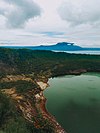Mounts Palay-Palay–Mataas-na-Gulod Protected Landscape
| Mounts Palay-Palay–Mataas-na-Gulod Protected Landscape | |
|---|---|
IUCN category V (protected landscape/seascape) | |
 View of the Palay-Palay Mountain Range in the far distance as seen from Naic | |
| Location | Cavite and Batangas, Philippines |
| Nearest town | Maragondon and Tagaytay |
| Coordinates | 14°12′56″N 120°39′11″E / 14.21556°N 120.65306°E |
| Area | 3,973.13 hectares (9,817.8 acres) |
| Established | October 26, 1976 (National park) June 27, 2007 (Protected landscape) |
| Governing body | Department of Environment and Natural Resources |
The Mounts Palay-Palay–Mataas-na-Gulod Protected Landscape is a 3,973.13-hectare (9,817.8-acre)
Description

The Palay-Palay protected landscape area is situated in the mountain range that forms the border between the densely populated provinces of Cavite and Batangas in the Calabarzon region. It contains parts of the municipalities of Maragondon and Ternate in Cavite and Nasugbu in Batangas and is spread over four barangays, namely Sapang, Pinagsanhan, Patungan and Papaya, and seven sitios, namely Malauyas, Caynipa, Caytako, Cacabay, Magabe, Murangdalig and Hamilo.[4] It is bounded on the north by the coves and beaches of Ternate including Caylabne Bay and Puerto Azul, on the south by the rolling hills and farmlands of Nasugbu, on the west by Limbones Cove, and on the east by the rolling plateau of Maragondon.
The mountain range consists of two prominent extinct volcanoes, namely Mount Palay-Palay at 688 metres (2,257 ft) high and Mount Mataas-na-Gulod, 642 metres (2,106 ft) high.

Bird sanctuary
The protected landscape is an important bird area having been initially proclaimed a game refuge and bird sanctuary. It is home to a diverse number of bird species such as the Philippine eagle-owl, Philippine falconet, Philippine hawk-cuckoo, Philippine drongo-cuckoo, Philippine hawk-owl, ashy thrush, brahminy kite, crested serpent eagle, Philippine fairy-bluebird, Philippine trogon, black-chinned fruit dove, island swiftlet, Philippine bulbul, Pacific swallow, Luzon hornbill and Philippine pygmy woodpecker.[8]
Accessibility

The park is located just 60 kilometres (37 mi) southwest of Manila and some 30 kilometres (19 mi) from the mountain resort city of Tagaytay. It is easily accessible via the new Ternate–Nasugbu mountain road completed in July 2013[9] which runs through the northwestern portion of the protected landscape from the western terminus of Governor's Drive in downtown Ternate to the seaside resorts of Nasugbu.[10] It is also accessible by ferry boat from the Mall of Asia Pier in Bay City, Metro Manila. The Hamilo Ferry Terminal is at Hamilo Coast in Nasugbu, about 4 kilometres (2.5 mi) from Palay-Palay.

A 38.3 kilometres (23.8 mi) trail traversing the mountains of the protected landscape has been mapped and established by a five-man expedition team in 2014, to which the trail starts at Barangay Ramirez of
See also
- Luzon rainforest
References
- ^ "Proclamation No. 1594, s. 1976". Official Gazette of the Republic of the Philippines. Retrieved October 26, 2014.
- ^ "Proclamation No. 1315, s. 2007". Official Gazette of the Republic of the Philippines. Retrieved October 26, 2014.
- ^ a b "PH011 Mounts Palay-Palay-Mataas na Gulod National Park". BirdLife International. Retrieved October 26, 2014.
- ^ "Physical and Natural Resources" (PDF). Cavite Provincial Government. Retrieved October 26, 2014.
- ^ . Retrieved November 5, 2017.
- GMA Network News. Retrieved October 26, 2014.
- ^ "Nature Trip". Maragondon Municipal Government. Retrieved October 26, 2014.
- ^ "Mount Palay-Palay". Wild Bird Club of the Philippines. Retrieved October 26, 2014.
- ^ Malicdem, Ervin (July 28, 2013). "Kaybiang Tunnel - The Gateway to the Western Coves of Cavite and Batangas". Schadow1 Expeditions. Retrieved November 5, 2017.
- ^ "Aquino woos Caviteños, raves over 'tourism road'". Philippine Daily Inquirer. Retrieved October 26, 2014.
- ^ Villarta, Rene (November 26, 2015). "A Sneak Peek of The Mt. Marami To Pico De Loro Trail Traverse". Jazz Runner. Retrieved November 5, 2017.
External links
![]() Media related to Mounts Palay-Palay–Mataas-na-Gulod Protected Landscape at Wikimedia Commons
Media related to Mounts Palay-Palay–Mataas-na-Gulod Protected Landscape at Wikimedia Commons


